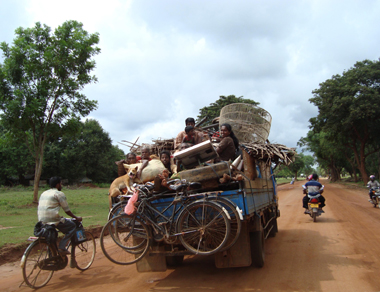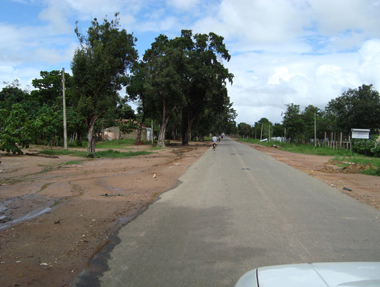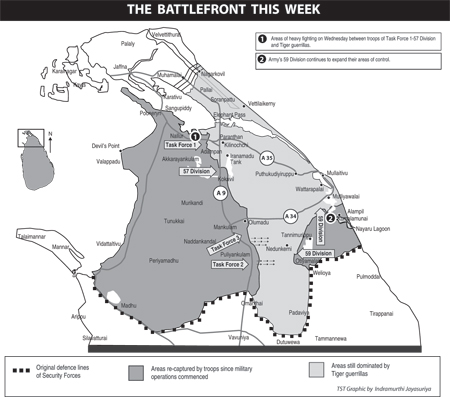For Imelda Sukumar, Government Agent of the besieged district of Mullaitivu, her office has become both a work place and home.
She believed the District Secretariat (Kachcheri) located alongside the hospital, in the heart of this strategic northeastern coastal town, is a safe location. Troops advancing to regain control of Mullaitivu, the military nerve centre of Tiger guerrillas, would not target her office building since the hospital lay next door. In fact, the relative calm in areas in and around her office in the past many weeks had only bolstered her confidence.
Last Monday, around 7 a.m. she was busy in her office with members of her staff. They had also taken up residence at the Secretariat. Suddenly the building shook as loud explosions reverberated in the area. Artillery shells had fallen on the Secretariat roof though they did not cause any damage inside the building.
Yet, that incident came as further proof that the ongoing Eelam War IV has reached a very decisive phase. The Army's 59 Division, which regained control of the northeastern coastal village of Alampil, once a staging area for Sea Tigers, was now on the outer fringes of the guerrilla fortifications that protect Mullaitivu. Troops are seven kilometres from this town. From locations astride the village of Mulliyawalai, the guerrillas were offering stiff resistance.
 |
| The civilian exodus from south of Mullaitivu. With whatever belongings they could move, those who can afford pay tractor owners to re-locate themselves. That includes even pet a dog. |
"Civilians in the area, particularly in the villages of Wattarappalai, Kumalamunai and Thannimuruppu have begun moving towards the District Secretariat," Ms Sukumar told The Sunday Times. She was speaking from the only telephone link that connects Colombo to Mullaitivu. "I have directed most of the displaced to Puthukudiyiruppu," she said. This small township is located on the Paranthan-Mullaitivu road. The new exodus of civilians will swell numbers already displaced from the western Wanni region. United Nations agencies have estimated the number there to be around 250,000 persons. They are all located in villages in the Mullaitivu district.
Troops of 59 Division have already seized a large extent of territory in the Weli Oya sector. Their advance in the days ahead will bring them to heavy fortifications the guerrillas have built to defend Mullaitivu. It is to enhance preparations further that cadres were withdrawn from areas far south of Mullaitivu. With the guerrillas now throwing in their hard-core cadres, Army sources do not rule out fierce fighting in the days ahead. Troops will thus have to overcome strong guerrilla resistance before they can take control of Mullaitivu.
With the fall of Pooneryn last month and the devastation caused by Cyclone Nisha two weeks ago, Tiger guerrillas had re-deployed their cadres and further fortified their defences around Kilinochchi. This became evident on Wednesday when troops of Task Force 1 and 57 Division, who were advancing in an easterly direction fought fierce battles at two different locations on the outskirts of Kilinochchi. Following heavy resistance, they later withdrew to their original positions.
Pro-guerrilla web sites which reported the incidents in detail gave the two locations as Ootupulam and Ariviyalnagar, located on the southern edges of Kilinochchi.
It has become clear that heavy guerrilla resistance is the main reason for the delay in re-capture of Kilinochchi. This is despite periodic claims in the past few months of regaining control of the town area, once the political power centre of the guerrillas. "Yet, troop morale is high and they are determined to go ahead," a senior officer in Wanni west told The Sunday Times on the telephone. He spoke on grounds of anonymity since he is not authorised to speak to the media. He said, "Since the re-capture of the first line of guerrilla defences at Muhamalai, they have inducted more hard core cadres to the second line. They have also strengthened Pallai (south of Muhamalai) and Kilaly areas."
 |
| Friday’s picture of the abandoned Kilinochchi town area. Cyclists pedal pedal past the Depot Junction in the town area. |
The Army is also worried about the easy use of the seas off Nagerkovil by guerrillas to induct cadres to the area. Two weeks ago, two guerrillas who tried to enter were shot dead. The Army has also warned troops in Wanni west to be wary of guerrilla attempts to infiltrate cadres with military supplies. This followed reports that moves were afoot to do so from Vettilaikerny in the northeastern coast to Devil's point in the western coast.
The first line of guerrilla defences at some points separated troop positions earlier by only some 50 metres. Reports this week said the guerrillas had shifted gun positions after floods affected earlier locations. Construction work to fortify new defences and laying of mines are still under way in this sector.
For reasons that are obvious now, details of casualties or those missing in action in Wednesday's fierce encounters cannot be revealed. Senior officers at Army Headquarters, however, discounted reports in pro-guerrilla websites of troops incurring heavy casualties. Some of the web sites had also posted several photographs from the battlefront to buttress their claims that they inflicted heavy casualties.
At present, troops from four flanks are poised to move towards Kilinochchi. The closest are troops from Task Force 1 and the 57 Division. The two formations are moving together in an easterly direction and resistance to them has come from a ditch cum bund where the guerrillas are positioned. Their advance is along the Pooneryn-Paranthan Road. Wednesday’s confrontations took place midway, south of this road. In this area, troops this week captured three guerrillas reportedly on a reconnaissance mission. They confessed that they had arrived in the general area of Pooneryn by coming in boats from the Jaffna (Kilali) lagoon.
Besides this, 57 Division troops are also advancing north of Akkarayan towards Kilinochchi town. In addition, a column has moved to the south western edge of the Iranamadu irrigation tank. They are on the southeastern outskirts of the town. From Muhamalai, troops of 53 and 55 Division are now in the first line of guerrilla defence which they captured last month. The second guerrilla line is separated by some 500 metres at most points with 200 metres in others. Troops of Task Force 3 advancing east of the A-9 highway are barely a kilometre away from Nedunkerni. They are expected to link up with the 59 Division. See map on this page for details on the battlefront this week.
 |
Despite the ongoing military offensives, the government is continuing to move food stocks to the Wanni. With the displaced civilian population now concentrated in the Mullaitivu district, food stocks that arrive there are adequate only for a week, said Ms Sukumar. Stocks provided by the World Food Programme had been distributed. The first stock of Indian food aid too had been distributed. She was now waiting for fresh stocks to arrive.
Compounding the food situation further is the damage to crops. Vegetables were in short supply and prices were unconscionably high making them beyond the reach of the needy. "As a result of heavy rains, most houses have gone under water prompting residents to seek refuge elsewhere. In some cases several families live in one house. Others have to move to makeshift shelters," the government's senior most official in Mullaitivu district said.
Ms Sukumar said there was also an acute shortage of clothing and materials to construct temporary shelters for the displaced. As a result, a considerable number of civilians are unable to seek shelter in IDP centres. She said she had appealed to the Commissioner General of Essential Services in Colombo to permit traders to bring in clothing material in view of the Christmas season. The last occasion when such permission was granted, she said, was during the Hindu festival of Deepavali in October. However, stocks had arrived late. The Government had placed restrictions in the movement of clothing and construction material for temporary shelters because it says the ultimate beneficiary was Tiger guerrillas.
The consolidation of western Wanni sector goes on apace with priority being given to resume the land based supply route from Mannar to Jaffna peninsula. With this in mind, Military Intelligence sources said, the guerrillas were attempting to destabilise the Jaffna peninsula. The Army has foiled several attempts. Some of the recent detections give an idea:
- On December 10 at Koviladi, troops of the third battalion of the Sinha Regiment were on foot patrol when a guerrilla hurled a hand grenade and escaped to a house. There was an exchange of fire. When troops searched the house, they found the bodies of two guerrillas. They recovered a T-56 assault rifle, ammunition and grenades.
- On December 10, soldiers on patrol recovered near Kodikamam a T-56 assault rifle, magazines a large quantity of ammunition, 8 kilogrammes of C4 explosives, detonation cords, a night device, RPG launchers, CDMA phones and bottles of saline, a stethoscope and 25 packets of noodles.
- On December 11, the Military Intelligence unit attached to Army's 52 Division recovered from Mattuwal area hand grenades, a suicide jacket, a micro pistol, pouches and tins of fruit. An hour later, the same unit recovered from the same area a claymore bomb weighing five kilogrammes, detonators and ammunition.
The above are just three of many such detections made almost on a daily basis. The Army in the peninsula has also been alerted to the possibility of more guerrilla groups infiltrating the peninsula. This week, military intelligence operatives killed a senior guerrilla cadre who had infiltrated along with a group to Aralaganwila in the Trincomalee district. Four other guerrilla cadres were killed in Panama, north of block II of the Yala National Park by a special team of commandos.
The guerrillas have been forced to cede vast extents of land in the Wanni since military offensives began there over a year ago. Now, they have fortified a relatively smaller locality they are defending and deployed their hard core cadres, some of whom had remained in reserve. With that, at least last week, they avoided the fall of Kilinochchi by offering fierce resistance. Similarly, senior Army officials expect the guerrillas to offer resistance on their defences south of Mullaitivu. This is what makes the ongoing phase of the military campaign very decisive.
An important reality has emerged from more than one year of fighting in the Wanni. That is the fact that the guerrillas have been able to so far, despite the shrinking terrain they hold, offer heavy resistance to the troops. To do so, it is no secret, that their supply lines through the high seas still remain intact. That is how they are able to replenish stocks to direct artillery and mortar fire at troops. This is how they are able to obtain ammunition for their assault rifles, machine guns and explosives for their improvised devices. Therefore it is not an over estimation to say the guerrilla threat still remains. They have lost large tracts of land but are yet to lose their military capability fully. |



